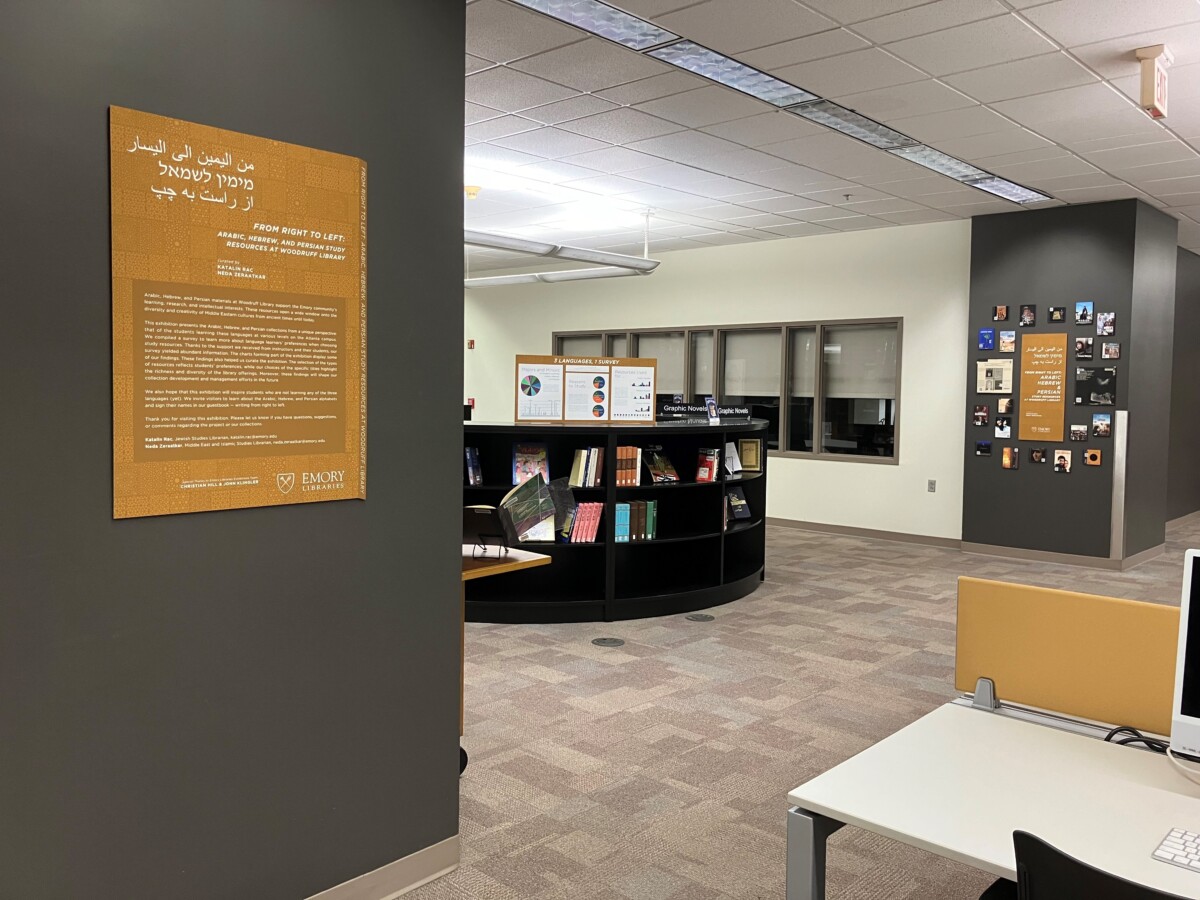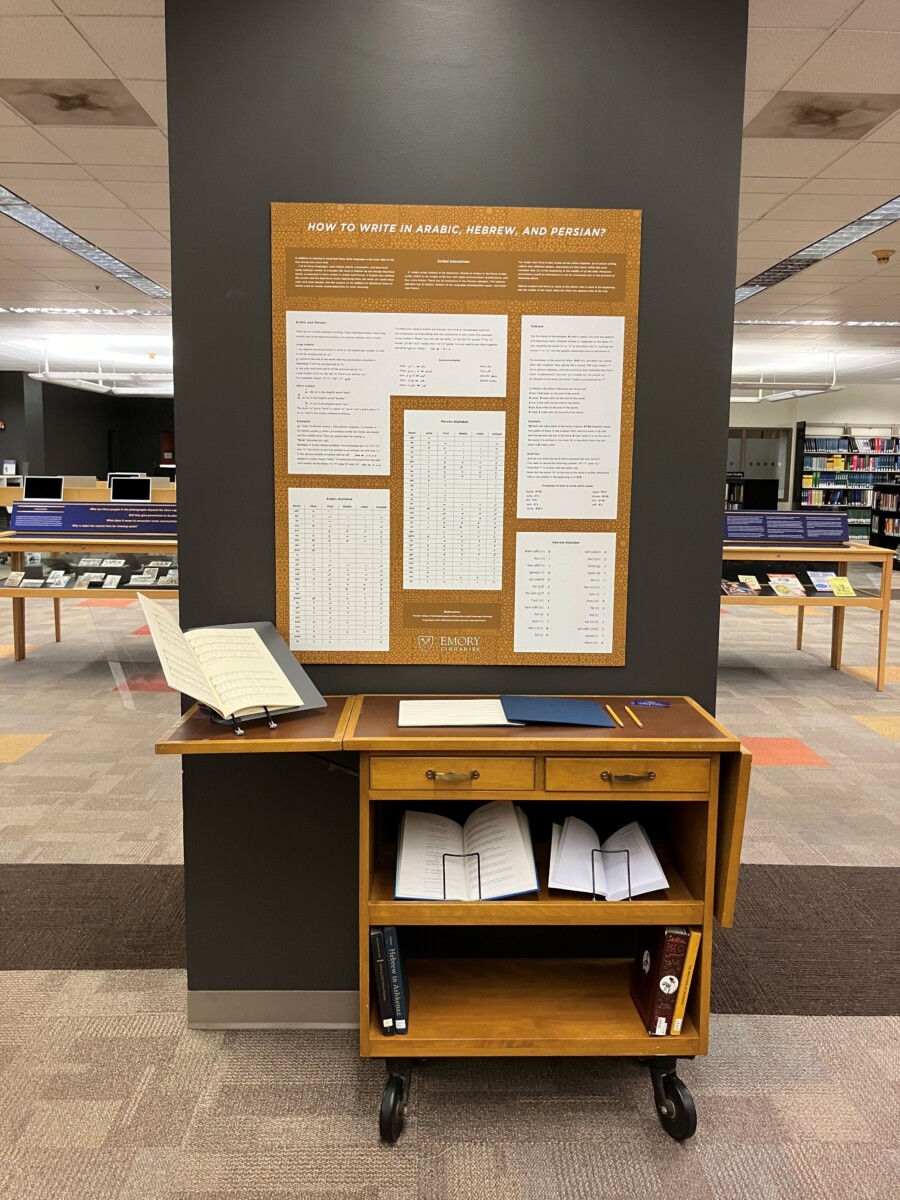
Exhibition space viewed from the entrance.
At the beginning of May 2024, when we installed the exhibition “From Right to Left: Arabic, Hebrew, and Persian Study Resources at Woodruff Library” on level 2 of Woodruff Library, we did not foresee that this space would become a classroom just in a few months. Next to classroom 215, on the righthand side of the hall on the way to the elevators, the exhibited items from the Arabic, Hebrew, and Persian language collections support instruction and learning of the three Middle Eastern languages at the Atlanta campus.
The exhibition place transformed into a classroom as a result of our collaboration with the instructors of Arabic, Hebrew, and Persian at the MESAS department and particularly per Hebrew teaching professor Pazit Kahlon-Shelnutt’s suggestion to welcome classes at the exhibition and, using this opportunity, to introduce students to the library’s collection.
The transformation started with the invitation of the MESAS department to their opening event for undergraduates in the department on August 26, 2024. We installed a smaller version of the exhibition on the Callaway South corridor and designed a small activity for students. As an extension of this event and in continuation of our discussion with the language instructors, we devised lesson plans to welcome students at the exhibition.

Media wall of “From Right to Left”
On Friday, September 6, 2024, as we welcomed the first groups of language learners and their instructors in the library, in a way we also closed a circle. In order to select the items for this exhibition, at the beginning of the year, we compiled a short questionnaire in three versions: Arabic-English, Hebrew-English, and Persian-English and brought it to the language courses. By filling out the survey, students helped us understand what types of resources they used to learn the language of their choice, why they decided to learn that language, and what their majors and minors were. We learned that poetry, movies, cookbooks, music, and graphic novels are among students’ most favored learning resources across all groups (in addition to their textbooks). We used the students’ answers to select the formats and genres featured at the exhibition. Per the suggestion of John Klinger, the designer of the exhibition, we created a media wall displaying movies and music recordings, while books were placed in the mid-section, on the shelves.

The writing corner is the interactive element of the exhibition.
On this first day of library instruction, four Hebrew language classes arrived at the exhibition (one group of students at the intermediate and three at the beginners’ level). Students learned or familiarized themselves with three key words in Hebrew pertaining to the world of libraries: ספר sefer (book), ספריה sifriya (library), and ספרנית safranit (librarian)—all three stemming from the root ס-פ-ר s-f-r. Next, students explored the exhibition and, closely inspecting an item of their choice, they talked about the modern Hebrew book and practiced using the catalog and retrieving books from the stacks. For many of them it was the first time to explore the Hebrew language collection in Woodruff Library. We expect Arabic and Persian learners to visit the exhibition later this semester, and we will offer them a similar lesson plan. As was the case with the bilingual survey, we offer our instruction sessions in Arabic, Hebrew, and Persian or in these languages with some clarifications in English.
We are grateful to the Hebrew language instructors Pazit Kahlon-Shelnutt, Sagit Ben-Simon, and Idit Shaked for bringing their students to our exhibition. We are also grateful that, like many other visitors, they signed our guestbook in four scripts. The guestbook is in the writing corner, the third interactive element of the exhibition. It is situated across the media wall and, in addition to the guest book and pencils, includes charts with the three alphabets and scribal instructions. It awaits every visitor until October 2024 interested in learning how to sign their names in Arabic, Hebrew, and Persian.
—by Katalin Rac, Jewish Studies librarian and Neda Zeraatkar, Middle East and Islamic Studies librarian
